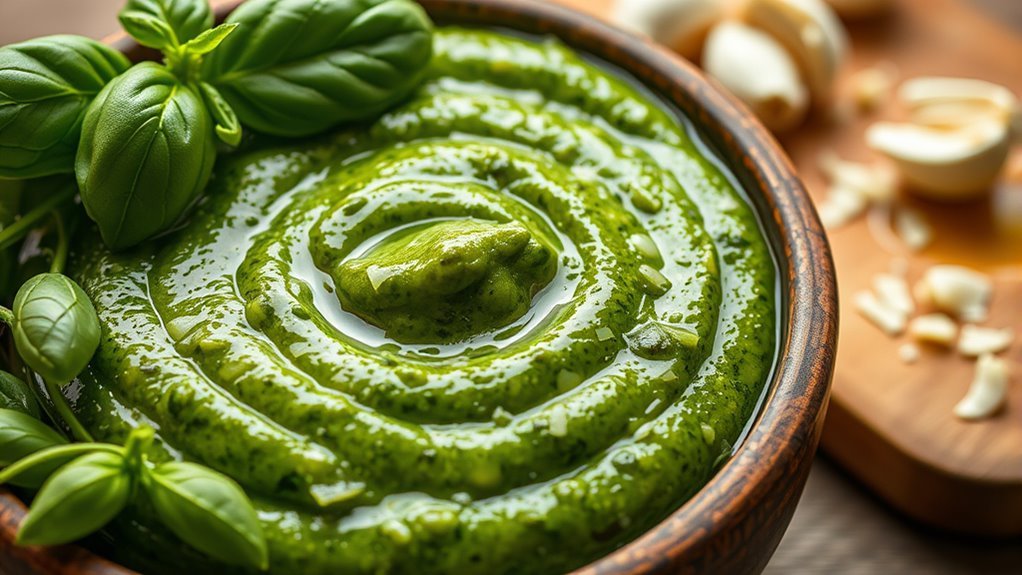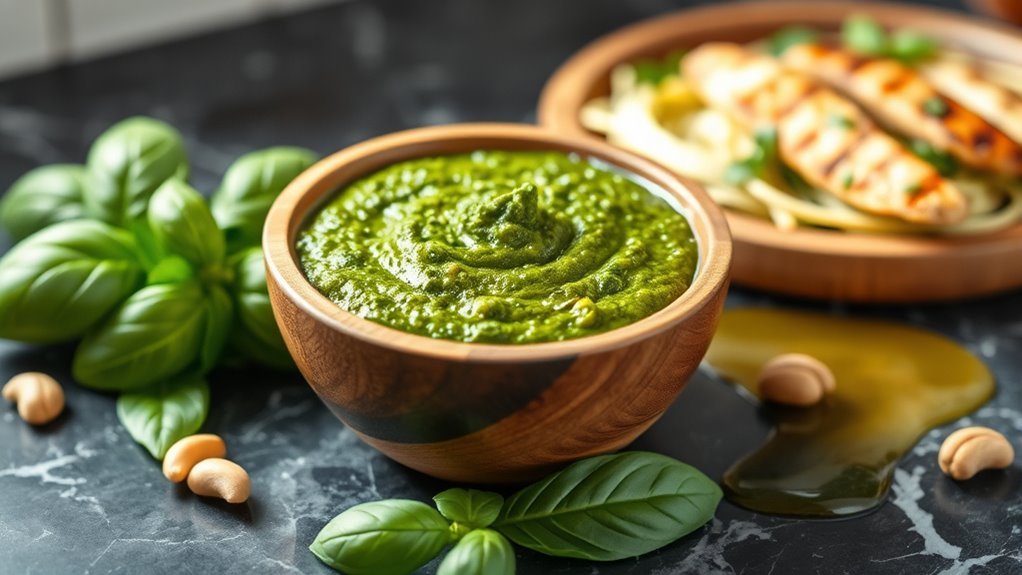Yes, pesto is keto-friendly! A typical two-tablespoon serving contains only 1-2 grams of carbohydrates, making it a great addition to your low-carb meals. It’s made from ingredients like fresh basil, garlic, and olive oil, which provide healthy fats and flavor while keeping carb counts low. Just be cautious with store-bought versions, as they may contain hidden sugars. If you want to explore more about making or using pesto on your keto journey, there’s plenty to discover!
Understanding Traditional Pesto Ingredients

When you think about pesto, the vibrant green sauce often comes to mind, bursting with flavor and freshness. Traditional pesto typically features a blend of fresh basil, garlic, pine nuts, Parmesan cheese, and olive oil. Each of these ingredients contributes unique flavor profiles that create the sauce’s signature taste. The basil brings an aromatic, slightly peppery note, while garlic adds a pungent kick. Pine nuts lend a buttery richness, and Parmesan enhances the umami aspect. Olive oil ties everything together, offering a smooth, velvety texture. Understanding these traditional ingredients helps you appreciate pesto’s complexity fully. Whether you’re making it from scratch or buying it pre-made, knowing what goes into this beloved sauce allows you to enjoy its vibrant flavors guilt-free.
Nutritional Breakdown of Pesto

Pesto’s nutritional profile is as rich and varied as its flavor. When you look at pesto nutrition, you’ll notice it’s packed with healthy fats, primarily from olive oil and nuts. These fats are essential for your body, supporting heart health and aiding in the absorption of fat-soluble vitamins. A typical serving of pesto contains around 80-100 calories, with a significant portion coming from these healthy fats. Additionally, you’ll find small amounts of protein from the cheese and nuts, while the herbs contribute vitamins and antioxidants. This combination not only enhances flavor but also makes pesto a nutrient-dense choice. Incorporating pesto into your meals can be a delicious way to enjoy healthy fats while keeping your diet balanced and satisfying.
Carbohydrate Content in Pesto

The carbohydrate content in pesto is relatively low, making it a suitable option for those following a ketogenic diet. Typically, a two-tablespoon serving of traditional pesto contains about 1-2 grams of carbohydrates. However, it’s important to take into account different pesto variations, as some may include higher carbohydrate sources like sun-dried tomatoes or beans.
Here are some points to keep in mind:
- Basil Pesto: Generally low in carbs.
- Spinach Pesto: Similar carb content, great for variety.
- Nut-Based Variations: Like walnut or almond pesto, slightly higher in carbs.
- Store-Bought Options: Always check labels for hidden sugars.
Keto-Friendly Pesto Alternatives
If you’re looking to mix things up while keeping your keto diet on track, there are several pesto alternatives that can deliver similar flavors with even fewer carbs. For instance, consider using basil or cilantro as herb variations, blending them with olive oil, nuts, and cheese for a fresh twist. Nutritional substitutes like pumpkin seeds or hemp seeds can replace traditional pine nuts, adding healthy fats without the extra carbs. You could also try avocado pesto, which incorporates ripe avocado for creaminess and additional nutrients. Experimenting with these alternatives not only keeps your meals exciting but also guarantees you stay aligned with your keto goals. Enjoy exploring these flavorful options that cater to your dietary preferences.
How to Incorporate Pesto Into Your Keto Diet
Incorporating pesto into your keto diet can be both delicious and straightforward, especially with the right approach. Here are some simple ways to enjoy pesto while keeping your meals keto-friendly:
- Zoodles: Toss zucchini noodles with pesto for a fresh, low-carb pasta alternative.
- Salad Dressing: Blend pesto with olive oil and vinegar for a tasty salad dressing.
- Protein Marinade: Marinate chicken or fish in pesto before grilling or baking for added flavor.
- Meal Prep: Use pesto as a base in your meal prep jars, combining it with roasted vegetables and protein for quick, satisfying meals.
With these pesto pairings, you’ll find it’s easy to stay on track with your keto goals while enjoying vibrant flavors!
Homemade Keto Pesto Recipe
Creating your own keto pesto at home not only guarantees you’re using low-carb ingredients, but it also allows for customization to suit your taste. Start with fresh basil, pine nuts, garlic, Parmesan cheese, and olive oil. Blend these ingredients until smooth, adjusting the oil for desired consistency. You can experiment with homemade variations by adding spinach for extra nutrients or swapping pine nuts for walnuts or almonds. If you’re dairy-free, nutritional yeast can replace Parmesan. These ingredient substitutions not only maintain the keto-friendly aspect but also cater to your preferences. By making your pesto, you embrace culinary freedom while ensuring it aligns perfectly with your keto lifestyle. Enjoy your delicious creation on zoodles, salads, or as a dip!
Tips for Storing and Using Pesto on Keto
When it comes to storing pesto for your keto meals, proper guidelines can make all the difference. You’ll want to contemplate refrigeration for short-term use and freezing for longer storage. Plus, exploring creative ways to incorporate pesto into your dishes can elevate your keto experience.
Refrigeration Storage Guidelines
To guarantee your pesto remains fresh and flavorful while adhering to a keto lifestyle, proper refrigeration and storage are essential. Here are some refrigeration tips to maximize your pesto’s shelf life:
- Use an Airtight Container: Store your pesto in a glass or plastic container with a tight lid to prevent air exposure.
- Cover with Oil: Pour a thin layer of olive oil on top of the pesto before sealing to minimize oxidation.
- Label and Date: Always label your container with the date to track freshness and avoid consuming expired pesto.
- Refrigerate Promptly: After making or opening pesto, refrigerate it within two hours to maintain its quality and safety.
Following these guidelines guarantees your keto-friendly pesto stays delicious longer!
Freezing for Long-term Use
Freezing pesto is a great way to guarantee you always have this flavorful sauce on hand while sticking to your keto diet. For long-term storage, consider using ice cube trays or silicone molds for portion control. After freezing, transfer the pesto cubes to airtight freezer bags, ensuring you remove as much air as possible to prevent freezer burn. This method allows you to easily grab just the right amount when needed. Alternatively, you can freeze pesto in a jar, but leave space at the top for expansion. Remember to label your containers with the date to keep track of freshness. Properly frozen, pesto can last up to six months, ensuring you can enjoy this keto-friendly delight anytime!
Creative Usage Ideas
Although pesto is often seen as a pasta topping, it can be creatively incorporated into your keto meals in various ways. Here are some delicious pesto pairings for your next creative dishes:
- Salad Dressing: Mix pesto with olive oil and vinegar for a flavorful salad dressing.
- Veggie Dip: Use pesto as a dip for fresh, low-carb vegetables like cucumbers and bell peppers.
- Eggs: Stir a spoonful of pesto into scrambled eggs or an omelet for an herbaceous kick.
- Meat Marinade: Marinate chicken or fish in pesto before grilling or baking to infuse them with rich flavors.
These ideas not only enhance your meals but also keep your keto journey exciting and satisfying. Enjoy experimenting!


